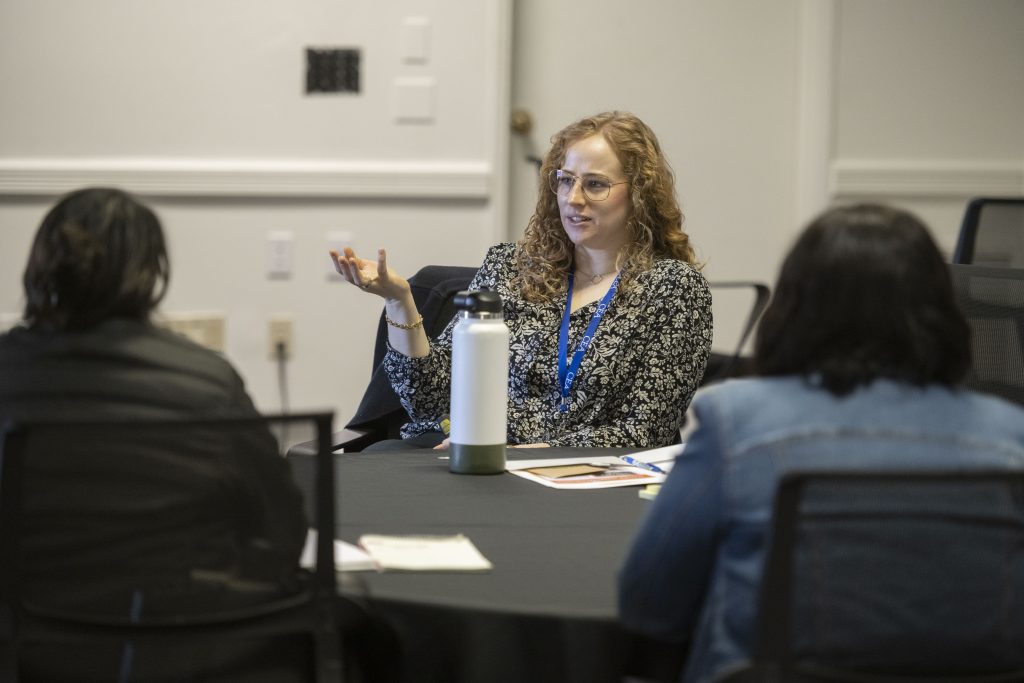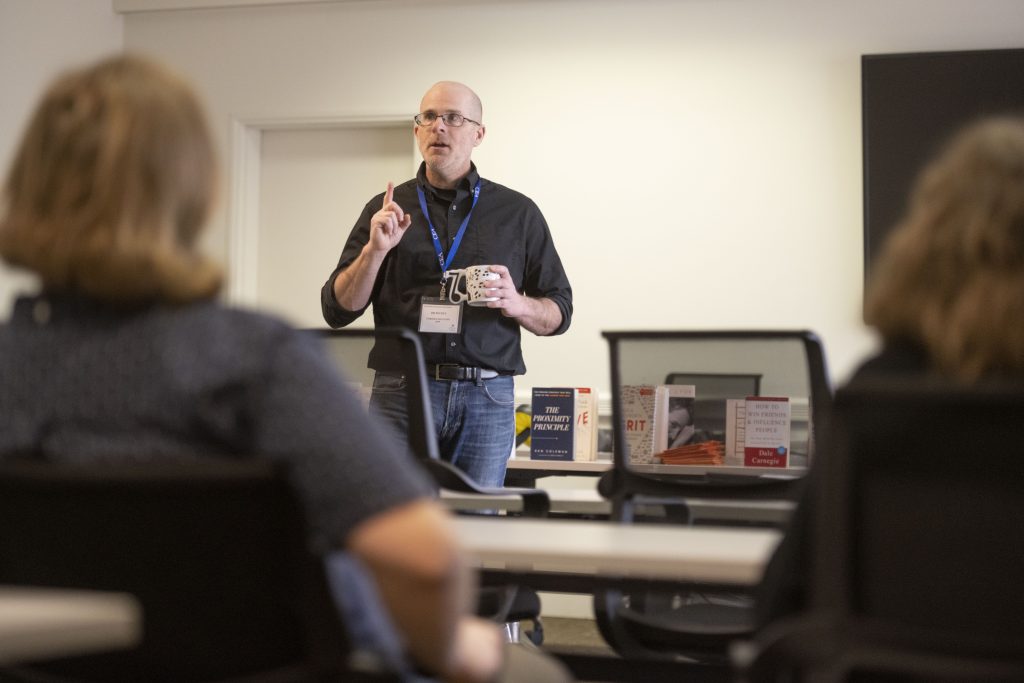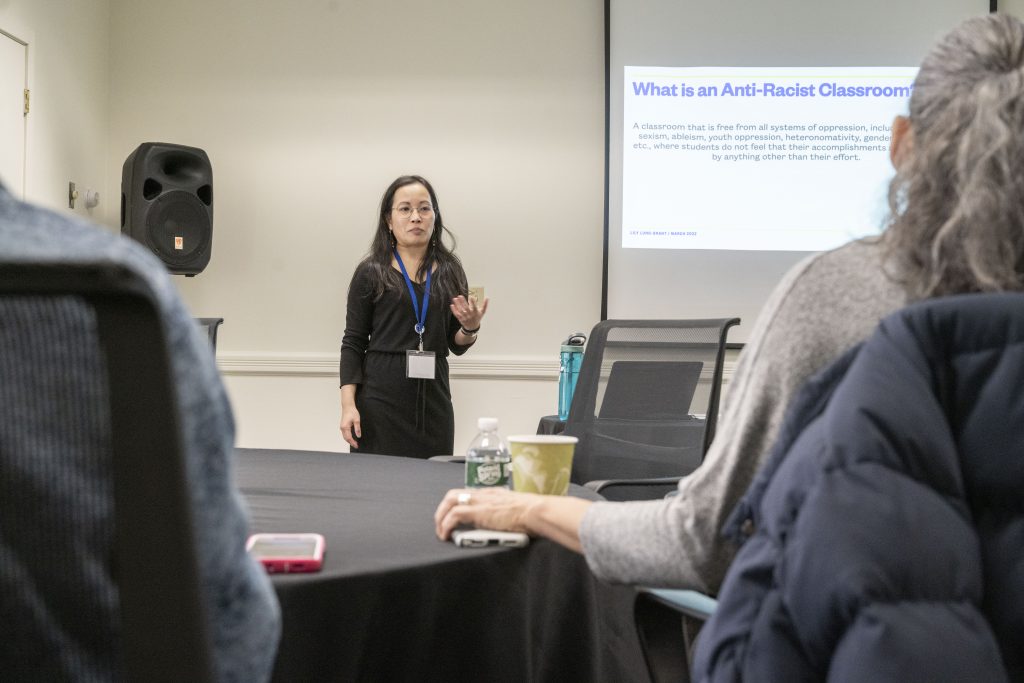New and aspiring educators from every part of the state came together for a day of professional development at CEA’s Early Career Educator Conference in Southbury last Saturday, and came away with fresh ideas for their classrooms as well as stronger connections with colleagues and mentors.
“After the pandemic put a hold on in-person gatherings like this, it was nice to welcome so many of our new teachers and provide a face-to-face forum for them to meet, learn, and share their experiences,” said CEA President Kate Dias.
Participants were able to choose from a variety of workshops on timely topics, including decreasing anxiety in the classroom, incorporating inquiry to enhance student engagement, creating anti-racist classrooms, teaching with technology, working with English language learners, using escape room activities to promote social emotional learning, problem-solving, classroom management, and more.
“I’m excited to come out and network with other teachers and keep adding to my knowledge,” said Michael Jones, a third-year English language arts teacher at Waterbury’s Crosby High School.
First-year Ridgefield High School business teacher Bob Keyes, who pivoted to teaching through Connecticut’s ARC program after a 25-year career as a lawyer, echoed Jones’s sentiment.
“I’m here to learn and interact with other educators,” said Keyes, adding, “I’m interested in bringing new technology into the classroom and keeping students engaged. My department is collaborative and growing, I feel well-supported in my district, and my students are great. They make me laugh and smile every day. But I also know that kids today have a lot of anxiety, and I want to ensure my classroom is a compassionate, nonjudgmental environment for them.”
Marvin Hicks, a fourth-year computer/information science teacher at Bridgeport’s Harding High School, also came to teaching as a second career, after retiring as an engineer with AT&T Labs.
“Teaching is hard work,” he said. “Coming here has made me feel energized and better equipped to do that work.” Hicks, who works with a number of English language learners, participated in sessions on engaging ESL students and using the question formulation technique (QFT) to enrich learning.
Your voice, your tribe
In her welcoming remarks, Dias described her own journey as an educator and union member and the “tribes” she has joined along the way.

Manchester teacher Katie Grant led a workshop for other early career educators on teacher self care.
Recalling her early days as a substitute teacher in an alternative education program with tremendous freedom, few constraints, and little guidance, she said, “It was terrifying, but also there was lots of room for creativity.” Later, she taught in a regular classroom—often with 30 students crowded into it—before expanding outside the classroom into leadership roles within her local and statewide union.
“I stand here as the sum total of the people who have guided me to this place, which includes my alternative education tribe, my regular education tribe, and my union tribe. I learned how I could be good for my kids. Then I learned how I could be good for my colleagues. I’ve never left any of these tribes; I take them with me.”
Becoming active in her union, said Dias, taught her about the importance of teacher voice.
“And that’s one of the things I want you to think about throughout the day today: the power of your voice. I encourage you to use the tribes you run with to develop your voice. This is a powerful time for us as educators. Whether this is day one or day 3,001, your voice matters. Maybe it matters to the person next to you. Maybe it matters to your local union president. Find your voice, your message. Say what you have to say—because it matters.”
Advocating for students
With a widespread and worsening crisis in children’s mental health, recognizing anxiety in students and minimizing it were primary goals for many conference attendees.

Fairfield teacher Jim Buchta.
Fairfield music teacher and band director Jim Buchta led a session aimed at helping teachers do both.
Having experienced the debilitating effects of his own child’s undiagnosed anxiety and somatic symptom disorder, Buchta understands what a mental health emergency looks like from a parent’s perspective as well as a teacher’s.
“Parenting is the most emotionally charged job, and parents will challenge you when their child is in trouble,” he explained. “They may come after you really hard, but that has the potential to make you a better teacher. The longer you teach, you’ll get ahead of those problems, but in the early years you’re flying by the seat of your pants.”
Buchta shared deeply personal stories, helpful readings, and an ever-expanding toolbox for reducing anxiety in the classroom and beyond.
“This session resonated with me because I see the anxiety in my students, in my colleagues, and in myself,” said Housatonic Valley High School teacher Beth Foulds. “It’s helpful to see that we’re not alone. The strategies I learned here reignited my desire to incorporate new ways of reducing anxiety, both in my role as a teacher to my students and as a union leader for my colleagues.”
Foulds, a 26-year veteran teacher and president of the Housatonic Valley Regional Faculty Association, invited her district’s new teachers to participate in the conference—and joined them.
“It’s a great offering not only for our new teachers but all educators, because we’re lifelong learners,” she said.
Colleague Rene Boardman, in her third year teaching agricultural and natural resources at Housatonic Valley High School, agreed.
“There are a lot of tools and insights to be gained from this training, and that’s true at any point in your career.”
Empowering our students, ourselves
Teachers were also keen to learn about promoting diversity, particularly as conversations about race and racism have become more prevalent, more urgent, and—at times—more volatile.
“You wouldn’t know it to look at me, because I’m white and heterosexual, but I was an at-risk kid, and teachers saved my life,” a social studies teacher confided. “As an adult, I’ve been awakened to systemic racism and stereotyping. I see it in my district. Once you see systemic racism, you can’t unsee it.”

Glastonbury teacher Lily Lung-Grant.
“As a Black Latina woman, I am the only educator of color my students see,” Southington health teacher Kimberly Phillips shared with colleagues in Lily Lung-Grant’s workshop on creating an anti-racist classroom. “I’m open to questions from my students, and I encourage them to ask me anything.”
Lung-Grant, a Chinese American music teacher in a majority white town—Glastonbury— applauded that approach and noted that it’s a two-way conversation, particularly when students represent minority groups. An anti-racist classroom, she said, is free from racism, sexism, ableism, youth oppression, heteronormativity, gender binarism, and all systems of oppression; that involves close and constant scrutiny of the texts, images, and words we use.
“If you’re stuck, ask your students questions. Even if you’re not stuck, ask your students questions. Invite challenges and admit you’re fallible but doing your best. We’re all learning. I’m still working on everything.” She added, “Don’t feel like you don’t have the right to teach about race or racism because you’re white. Learn and empower yourself. It’s brave work.”
She also discussed the progression of language that’s been used in the move toward anti-racism. “We used to say ‘tolerance,’ but I don’t like that term. You tolerate a bad smell. I don’t want to be a bad smell. ‘Acceptance’ has also been used, but it comes from above. When you accept someone, you’re often doing so from a position of authority or superiority. ‘Celebration’ is better, but it can suggest a separation between you and whomever you’re celebrating. I like ‘solidarity.’ When I stand together in solidarity with you, I am an ally, and there is not necessarily a hierarchy.”
For more on creating an anti-racist classroom, see an upcoming issue of the CEA Advisor.







